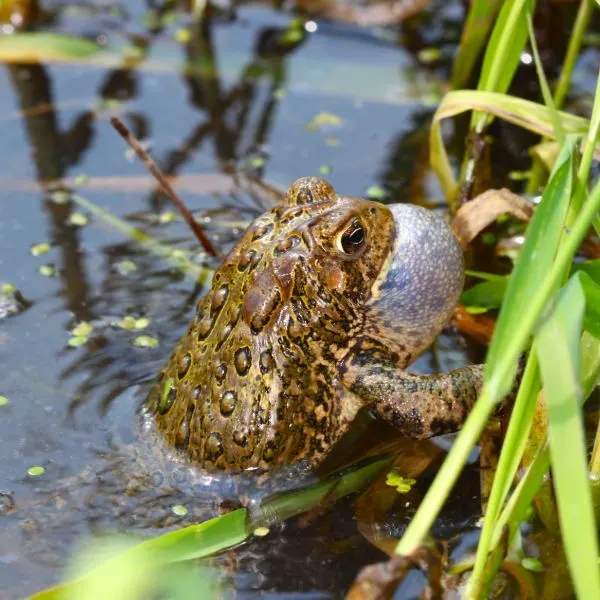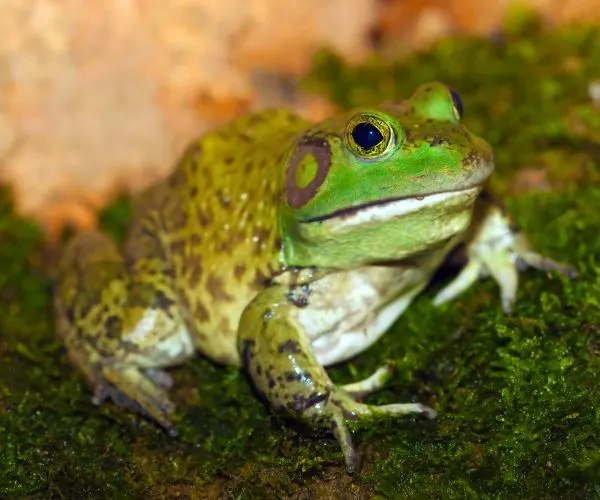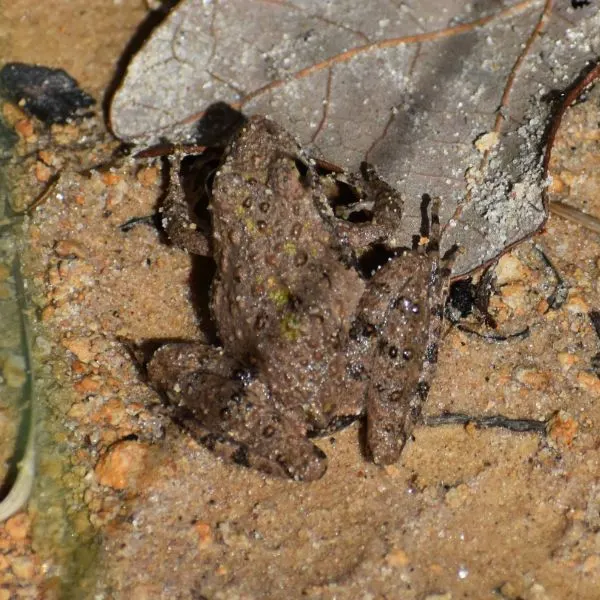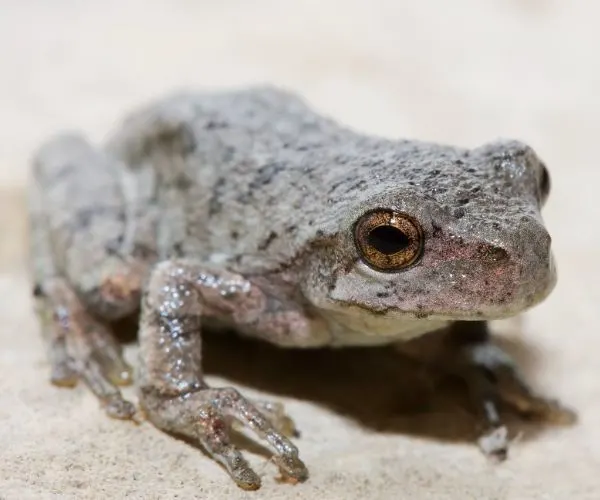There are 12 different species of frogs in Wisconsin. They live near water sources across the state and use them for breeding. Frogs are a sign of a healthy habitat and can even be found near residential areas. They are a vital part of the ecosystem and help keep it balanced.
In this article you’ll find all of the Frogs in Wisconsin that live in the many forest and water habitats within the state. 12 different species of toads, true frogs and tree frogs that inhabit the state. Let’s take a look at all the species of frogs and what makes each one unique.
Table of Contents
Frogs In Wisconsin
1. American Toad

- Experience Level: Beginner
- Family: Bufonidae
- Scientific Name: Anaxyrus americanus
- Other Names: Eastern American Toad
- Adult Size: 2 to 3 ½ inches
- Lifespan: 2 to 10 years
- Average Price Range: $20 to $30
The American Toad is Wisconsin’s only toad species. They can be found all over Wisconsin in habitats like moist woodlands where they like to burrow in the soil. They can also be found in prairies, gardens, meadows, and fields.These frogs spend most of their time on land but will move to water source to breed. Their thick wart covered skin helps it to retain moisture longer than aquatic frogs so it has less need to stay near water.
American toads are most commonly found with brown, gray, olive-green, or tan skin with a light stripe down the center of its back. Their skin is dry and covered in warts. These frogs have two large protruding glands on the back of their head that secrete a toxin to help defend against predators. This toxin is a skin and eye irritant and if ingested can cause vomiting.
A toad’s diet consists of insects and invertebrates including slugs, spiders, beetles and worms. Because toads have a large appetite for insects some gardeners keep toad houses to help with bug control.
2. American Bullfrog

- Experience Level: Intermediate to Advanced
- Family: Ranidae
- Scientific Name: Rana catesbeiana
- Other Names: Bullfrog
- Adult Size: 3 ½ to 6 inches
- Lifespan: 7 to 15 years
- Average Price Range: $20
The American Bullfrog is the largest frog in North America. They can be found in Wisconsin’s permanent bodies of water such as lakes, ponds, canals, and creeks.This species has been introduced in many areas because of its use as a food source. These frogs are considered an invasive species in some places.
Due to its large appetite and the high number of eggs they produce they can negatively impact other native species. They are often the species used for dissection in schools.
American Bullfrogs are most commonly a mixture of bright green and brown, olive-green, or gray. Their underbellies are often an off-white or cream with blotches of yellow or gray.
Their back legs are long while their front legs are stout and they have no webbing on their front feet and partial webbing on their back. Males are most often smaller than females and have yellow throats.
Bullfrogs have carnivore diets and can be cannibalistic, eating all types of things ranging from small insects and fish to small snakes and other smaller bullfrogs.
This species gets its name from their mating call which resembles a bull bellowing. They have three different calls: a mating call, a call to threaten other males, and a call to signal combat. Their breeding season takes place from May to late July.
3. Blanchard’s Cricket Frog

- Experience Level: Beginner-Intermediate
- Family: Hylidae
- Scientific Name: Acris crepitans blanchardi
- Other Names: N/A
- Adult Size: ⅝ – 1 ½ inches
- Lifespan: 1 year
- Average Price Range: N/A
Blanchard’s Cricket frog is currently listed as endangered in Wisconsin. They can be found in multiple types of habitats like ponds, lakes, marshes, meadows, and mud flats. They most commonly use slow-moving or stagnant bodies of water to mate in but can also use streams and rivers.
During winter these frogs use other animals’ burrows to hibernate and help keep them from freezing. They are active from March to November but are most active during their breeding season which takes place from May to mid-August.
This species is small and covered in warts. They are typically brown, tan, olive-green, or gray with dark spots or bands and a bright stripe of color going from the eyes down its back and forming a dark triangle on the top of its head.
They are slightly more susceptible to disease than other species due to its skin being highly vascularized which allows substances to absorb into the blood quicker. Blanchard’s cricket frogs have a distinct call that sounds similar to marbles being clicked together.
4. Cope’s Gray Tree Frog

- Experience Level: Beginner
- Family: Hylidae
- Scientific Name: Hyla chrysoscelis
- Other Names: N/A
- Adult Size: 1 to 1 ¼ inch
- Lifespan: 7 to 10 years
- Average Price Range: $20
Cope’s Gray tree frog can be found living in woodland habitats, but can sometimes be found in open fields when traveling towards a breeding pond. Shortly before the breeding season starts males can be heard calling from woodland areas or fields before they migrate to temporary water sources such as ponds, ditches, or flooded fields to breed.
These frogs are usually gray, green, or brown with a pale white underbelly and orange or yellow blotch on the inside of the hind legs. They use these yellow or orange markings to try and scare predators when they leap. Their skin is rough and covered in bumps resembling tree bark. The males throat is a gray or black color during breeding season.
Cope’s Gray tree frog can be difficult to distinguish from the Gray tree frog as they are both similar in size and color and share the same geographical range. The only notable way to tell the two apart would be by their call. This species’ call is faster and higher-pitched compared to the gray tree frogs.
5. Gray Tree Frog

- Experience Level: Beginner
- Family: Hylidae
- Scientific Name: Hyla versicolor
- Other Names: N/A
- Adult Size: 1 ¼ inches
- Lifespan: 7 to 10 years
- Average Price Range: $20
Gray tree frogs can be found in habitats with lots of trees and shrubs. These frogs are nocturnal and spend most of their time climbing in vegetation. They tend to breed in ponds, marshes, and man-made water sources. It is unlikely for them to lay eggs in permanent water due to fish and other predators.
This species’ color can change depending on their temperature and surroundings . They can be brown, gray, or olive-green and have dark blotches.They usually have dark or colored bands on their legs. Their snout is blunt and their skin is rough and covered in warts.
The Gray tree frog will eat different kinds of insects like snails, plant lice, slugs, beetles, and sometimes other small frogs. Predators can include snakes, birds and larger frogs. When inactive they will hide in tree holes, under logs, and other natural debris.
6. Green Frog

- Experience Level: Beginner
- Family: Ranidae
- Scientific Name: Lithobates clamitans melanota
- Other Names: N/A
- Adult Size: 2 ¼ to 3 ½ inches
- Lifespan: 15 to 20 years
- Average Price Range: $10
The green frog can be seen living near shallow ponds, ditches, lakes, streams, swamps, and brooks. They are usually seen sitting on the shoreline facing the water. They can be found in temporary bodies of water but are unlikely to breed in them. This species is very active at night but can be seen active during the day as well.
Green frogs tend to be brownish-green, or olive-green with a brighter green head. They have rough, wart covered skin with small dark spots on the lower back and hind legs. Their large, brown external eardrums being its most distinguishable feature. Male frogs during breeding have yellow throats while females’ remain white like the belly.
This species breeds from April to August but can remain active year round. These frogs tend to breed in permanent bodies of water. The male can be heard calling from underwater. Their call is said to be similar to the sound of loose banjo strings being plucked.
7. Northern Leopard Frog

- Experience Level: Beginner
- Family: Ranidae
- Scientific Name: Lithobates pipiens
- Other Names: Rana pipiens
- Adult Size: 3 ½ to 4 ½ inches
- Lifespan: 2 to 4 years
- Average Price Range: $10 to $15
The Northern Leopard frog can be found in a variety of habitats such as ponds, bogs, swamps, marshes, lakes, and other fishless waters. They can be found quite a distance away from the water while foraging like in old fields, meadows, and prairies. These frogs prefer slow-moving or still waters with lots of aquatic vegetation.
This species is usually green, olive green, brown or tan with large dark spots on its back and legs.These spots tend to have white or yellow borders. These frogs look similar to the Pickerel frog but can be distinguished by their more round spots and its two light colored dorsolateral folds that run from the base of the eye to the end of its body.
Northern leopard frogs breed from March to June and hibernate underwater from October to March. They eat a variety of different insects and animals including worms, flies, beetles, spiders, smaller frogs, birds, and snakes. Northern leopard frogs produce specific enzymes that have a potential use in treatment for cancer, lung tumors, and brain tumors.
8. Pickerel Frog

- Experience Level: Intermediate
- Family: Ranidae
- Scientific Name: Lithobates palustris
- Other Names: Rana palustris
- Adult Size: 1 ¾ to 3 inches
- Lifespan: 5 to 8 years
- Average Price Range: $10 to $15
The Pickerel frog is a species of special concern in Wisconsin. These frogs are active from March to November but may also be partially active under water during the winter.
These frogs like to hibernate in cold water streams, pools, or spring holes and can be found hiding under water cress. They can be found on land during most of their active periods foraging for food along the water’s edge.
These frogs are most commonly seen having brown, gray, golden-brown, or olive green skin with two parallel rows of square shaped spots along its back. They have orange or yellow blotches on the inside hind leg.
This color is concealed until the frog is threatened and when it hops it shows the color to try and scare off predators. Pickerel frogs secrete a substance that can be toxic to predators; it can irritate the human skin and eyes.
This species is usually found calling from underwater or surrounding vegetation. Their call sounds like a low-pitched snore similar to a leopard frog. The only way to distinguish the two is by appearance.
The pickerel frog spots are more square shaped and in more consistent lines. They are usually found calling from underwater or on debris in the water.
9. Spring Peeper

- Experience Level: Intermediate
- Family: Hylidae
- Scientific Name: Pseudacris crucifer
- Other Names: Spring peeper
- Adult Size: ¾ – 1 ¼ inch
- Lifespan: 2-4 years
- Average Price Range: $10-$20
The spring peeper is a small frog that can be found in moist forests and temporary wetlands like marshes, small ponds, swamps, and flooded fields. During the winter they can be found hibernating behind loose tree bark or under logs and other debris. The Wisconsin Frog and Toad Survey shows this species to be in decline.
Spring peepers can be brown, olive-green, tan, or gray with white or cream colored bellies. These frogs can be distinguished from other species in the area by the dark brown or black x-shaped stripes on their back.
They have large toe pads to help them climb vertically on vegetation though they are more commonly found on the forest floor under leaf litter and debris.
This species is nocturnal so they can be found hunting for their food at night. Spring peepers have a diet consisting of small insects like beetles, flies, ants, spiders, and moths. These frogs breed depending on temperature in their area. In Wisconsin they breed from March to June when there are warm rainy days.
10. Wood Frog

- Experience Level: Beginner
- Family: Ranidae
- Scientific Name: Lithobates sylvaticus
- Other Names: Rana sylvaticus
- Adult Size: 1 ⅜ to 2 ¾ inches
- Lifespan: 1 to 3 years
- Average Price Range: $15 to $30
Wood frogs like to make their home in moist wooded areas with temporary fishless bodies of water they can use during breeding season such as ponds created by melted snow or rain. These frogs become active on warm, rainy nights and can sometimes be found along the side of the road during them.
The wood frog can be shades of pinkish-brown, reddish brown, olive green, tan, brown, and gray. Females tend to be more brightly colored than males. These frogs have a very distinct white line above its lip and black or brown stripe that starts at the snout and then becomes thicker around the eyes, somewhat resembling a mask.
This species has a diet of insects and small invertebrates like spiders, slugs, snails, caterpillars, and beetles.Their breeding season starts around early March and lasts only two weeks. These frogs have the shortest breeding season of any Wisconsin frog.
11. Mink Frog

- Experience Level: Intermediate
- Family: Hylidae
- Scientific Name: Lithobates septentrionalis
- Other Names: north frog
- Adult Size: 1 ¾ to 3 inches
- Lifespan: 5 years
- Average Price Range: N/A
The mink frog is a species of special concern in Wisconsin. They are named for their scent which is said to be similar to a mink which is a mammal that smells somewhat like rotting onions. These frogs live in plants along the banks of ponds, swamps, lakes, rivers, and streams. Their eggs are normally found near floating vegetation.
This species is commonly seen having a mixture of green and yellow skin with dark brown or black blotches all over the head, back and hind legs. These frogs typically have bright green lips. The mink frog’s belly is typically white, yellow, or cream with the male having a bright yellow throat and the females having a white one.
These frogs breed from May to July. The males can be seen calling for a mate while floating on the water’s surface or atop floating debris.This frog’s mating call sounds similar to a hammer hitting wood and when they call in a chorus it sounds like horses’ hooves.
12. Boreal Chorus Frog

- Experience Level: Intermediate
- Family: Hylidae
- Scientific Name: Pseudacris maculata
- Other Names: N/A
- Adult Size: ¾ – 1 ½ inches
- Lifespan: 1 to 3 years
- Average Price Range: N/A
The Boreal chorus frogs look almost identical to the Western chorus frog.They can be distinguished by their mating call which sounds similar to running your finger over the teeth of a comb. These frogs can be found living around woodland ponds, ditches, swmaps, marshes, and shallow lakes. Their eggs can usually be found attached to aquatic vegetation.
This species is typically gray, green-gray, olive-green, or brown with smooth skin. They are commonly seen with three dark stripes down its back and a white line above the lips. They have white or pale yellow bellies.
Breeding season happens from April to September. During these months the male can be seen calling from vegetation surrounding the breeding pond. These are usually the first frogs seen in spring. They emerge when the snow melts and the water level rises in the body of water it calls home.
Wrapping up
In Wisconsin there are 12 different species of frogs and toads to be found within the state. It’s appearance, location, mating call and what time it is active can help identify one species from the next. Most frogs are active in cool temperatures and will hide underground to avoid the heat.
Some of the frogs and toads on this list can make great pets If taken care of properly. Species like the Northern Leopard frog can be easily kept in captivity and live healthy lives. Bugs are what most species eat and can be fed to them in captivity.
Frogs are very important in keeping a balanced ecosystem and some of the species on this list have seen a decrease in population. Pollution and habitat destruction is a threat all species face. Keeping waters clean and protecting their habitats will help the 12 species that live in the state have a long future ahead of them.
Nearby states
